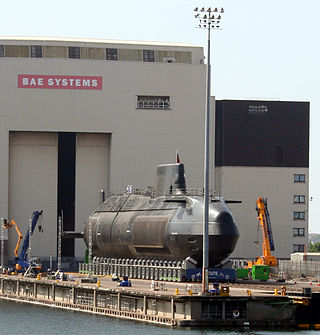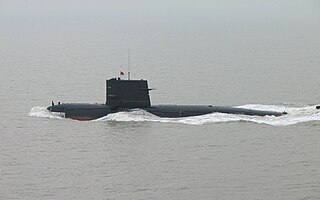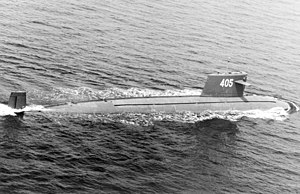
The Ohio class of nuclear-powered submarines includes the United States Navy's 14 ballistic missile submarines (SSBNs) and its four cruise missile submarines (SSGNs). Each displacing 18,750 tons submerged, the Ohio-class boats are the largest submarines ever built for the U.S. Navy. They are also the third-largest submarines ever built, behind the Russian Navy's Soviet era 48,000-ton Typhoon class, the last of which was retired in 2023, and 24,000-ton Borei class. Capable of carrying 24 Trident II missiles apiece, the Ohio class are equipped with just as many missiles as, if not more than, either the Borei class (16) or the deactivated Typhoon class (20).

The Seawolf class is a class of nuclear-powered, fast attack submarines (SSN) in service with the United States Navy. The class was the intended successor to the Los Angeles class, and design work began in 1983. A fleet of 29 submarines was to be built over a ten-year period, but that was reduced to 12 submarines. The end of the Cold War and budget constraints led to the cancellation of any further additions to the fleet in 1995, leaving the Seawolf class limited to just three boats. This, in turn, led to the design of the smaller Virginia class. The Seawolf class cost about $3 billion per unit, making it the most expensive United States Navy fast attack submarine and second most expensive submarine ever, after the French Triomphant-class nuclear-powered ballistic missile submarines.
The Ship-Submarine Recycling Program (SRP) is the process that the United States Navy uses to dispose of decommissioned nuclear vessels. SRP takes place only at the Puget Sound Naval Shipyard (PSNS) in Bremerton, Washington, but the preparations can begin elsewhere.

K-19 was the first submarine of the Project 658 class, the first generation of Soviet nuclear submarines equipped with nuclear ballistic missiles, specifically the R-13 SLBM. The boat was hastily built by the Soviets in response to United States' developments in nuclear submarines as part of the arms race. Before she was launched, 10 civilian workers and a sailor died due to accidents and fires. After K-19 was commissioned, the boat had multiple breakdowns and accidents, several of which threatened to sink the submarine.

K-222 was the sole Project 661 "Anchar" nuclear-powered cruise-missile submarine of the Soviet Navy during the Cold War. Although the Soviets saw K-222 as an unsuccessful design, upon completion it was the world's fastest submarine and the first to be built with a titanium hull.

An attack submarine or hunter-killer submarine is a submarine specifically designed for the purpose of attacking and sinking other submarines, surface combatants and merchant vessels. In the Soviet and Russian navies they were and are called "multi-purpose submarines". They are also used to protect friendly surface combatants and missile submarines. Some attack subs are also armed with cruise missiles, increasing the scope of their potential missions to include land targets.

USS Michigan (SSBN-727/SSGN-727) is an Ohio-class nuclear-powered guided missile submarine (SSGN), converted from a ballistic missile submarine (SSBN), that is part of the United States Navy. She is the third vessel to bear the name of the U.S. state of Michigan.

A nuclear submarine is a submarine powered by a nuclear reactor, but not necessarily nuclear-armed. Nuclear submarines have considerable performance advantages over "conventional" submarines. Nuclear propulsion, being completely independent of air, frees the submarine from the need to surface frequently, as is necessary for conventional submarines. The large amount of power generated by a nuclear reactor allows nuclear submarines to operate at high speed for long periods, and the long interval between refuelings grants a range virtually unlimited, making the only limits on voyage times being imposed by such factors as the need to restock food or other consumables.

Nuclear marine propulsion is propulsion of a ship or submarine with heat provided by a nuclear reactor. The power plant heats water to produce steam for a turbine used to turn the ship's propeller through a gearbox or through an electric generator and motor. Nuclear propulsion is used primarily within naval warships such as nuclear submarines and supercarriers. A small number of experimental civil nuclear ships have been built.
The Type 092 submarine was the first nuclear-powered ballistic missile submarine (SSBN) deployed by the People's Liberation Army Navy Submarine Force.

The Rubis class is a class of nuclear-powered attack submarines operated by the French Navy. It comprises six boats, the first entering service in 1983 and the last in 1993. Two additional units originally planned were cancelled as a result of post-Cold War budget cuts. All six submarines of the Rubis class are based at Toulon and are part of the Escadrille de sous-marins nucléaires d'attaque. Smaller than contemporary designs of other major world navies, the Rubis class shares many of its system designs with the conventionally-powered Agosta class. In the late 1980s, the Rubis class was proposed to Canada in the context of their plan to acquire nuclear-powered submarines.

The Type 039 submarine is a class of diesel-electric submarines of the People's Liberation Army Navy. The class is the first diesel-electric submarine to be made in China and also the first Chinese made diesel-electric submarine to use the teardrop hull shape. Altogether thirteen vessels were completed to the Song Class design between 1999 and 2006, with three variants as the type developed.

The Yasen class, Russian designations Project 885 Yasen and Project 885M Yasen-M, also referred to as the Graney class, are a series of nuclear-powered cruise missile submarines designed by the Malakhit Marine Engineering Bureau and built by Sevmash for the Russian Navy. Design work commenced in earnest in the 1980s with the first submarine built in the 1990s–early 2010s with commissioning in 2013. Two additional boats to an upgraded Yasen-M design were commissioned in 2021 and six more are under construction. Based on the Akula class and Alfa class designs, the Yasen class is projected to replace the Russian Navy's current Soviet-era nuclear attack submarines. The Akula class is optimised for a hunter-killer role, whereas the Yasen class concept uses the platform as a nuclear guided missile submarine (SSGN).

The People's Liberation Army Navy Submarine Force (PLANSF) is the submarine service of the People's Liberation Army Navy. It consists of all types of submarines in operational service organized into three fleets: the North Sea Fleet, the East Sea Fleet, and the South Sea Fleet. Submarines have long been one of the three focuses of the People's Liberation Army Navy, and when the decision was made in late 2006 to concentrate on building other principal surface combatants to strengthen the air defense and to further delay the construction of aircraft carriers due to insufficient air cover, submarines will continue to play the lead dominant role in the assault force for the PLAN. Currently, PLANSF operates a fleet of 66 submarines which include nuclear as well as conventional submarines.

The TR-1700 is a class of diesel-electric patrol submarines built by Thyssen Nordseewerke for the Argentine Navy in the 1980s, with two submarines completed. These ships are amongst the largest submarines built in Germany since World War II and are among the fastest diesel-electric submarines in the world. ARA San Juan was lost on 17 November 2017, leaving ARA Santa Cruz as the only remaining submarine of this class. As of 2020, the refit of Santa Cruz has been reported cancelled leaving the entire class inactive.
The Type 093 submarine is a class of nuclear-powered attack submarines constructed by the People's Republic of China for the People's Liberation Army Navy (PLAN).
The Type 035 submarine is a class of diesel-electric submarines of the People's Liberation Army Navy. The Type 035 is a heavily improved redesign of the older Type 033 submarines, which were built in China from 1962 to 1984.

Changzheng 1 (401) is a Type 091 nuclear attack submarine of the People's Liberation Army Navy.
The K-154 Tigr is an Akula-class submarine in the Russian Navy.















